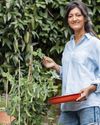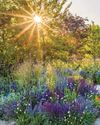
It always saddens me that Americans call their garden a 'backyard'. The very sound conjures up images of a concrete jungle that needs nothing more than a broom to keep it in good order. 'A garden', on the other hand, brings to mind a green haven erupting with blossom, abuzz with bees and a-flutter with birds.
And it is wildlife that makes a garden special, transforming it into a living, breathing piece of nature. Yes, the gardener likes to be in control, but the wise and thoughtful gardener - the kind gardener - understands that a garden is a place where all forms of life can meet and co-exist for mutual benefit, and that includes humankind.
Without bees and butterflies, birds and amphibians, mammals and insects a garden is a sterile thing, a place that might look neat and tidy but which offers little in terms of environmental enrichment. We have a duty of care to the natural world, but it is a duty that can be far from onerous. As gardeners, we are at the sharp end of conservation and ecology, and on our own patch, by adjusting the way we intervene, we can make a real difference to the lives of those creatures that share our space and they, in turn, add so much to our own existence.
The wildlife garden
No matter how small your patch, the way in which you manage it will make all the difference to its value to the natural world. For a start, stop being so tidy. I don't mean that leaving out plastic toys and the whirligig washing line is acceptable (the whirligig is a regular bone of contention in many a garden), but stop and think before you manicure every inch of your plot.
This story is from the May 2023 edition of BBC Gardeners World.
Start your 7-day Magzter GOLD free trial to access thousands of curated premium stories, and 9,000+ magazines and newspapers.
Already a subscriber ? Sign In
This story is from the May 2023 edition of BBC Gardeners World.
Start your 7-day Magzter GOLD free trial to access thousands of curated premium stories, and 9,000+ magazines and newspapers.
Already a subscriber? Sign In

A new plot for tasty crops
Taking on a new allotment needn't be hard work. By simply following a few easy tips you can have bumper crops in no time, just like Alessandro Vitale

We love July
July is an island floating between the joy of June and the slightly fatigued month of August. It's a grown-up month: the year has shrugged off its adolescent exuberances, the weather is (hopefully) warm enough for ice cream to be one of your five a day, the sea should be swimmable without (too much) danger of hypothermia and thoughts will be of holiday shenanigans and family barbecues. School's out this month, the next tranche of glorious summer colour is washing across our borders and it's my birthday. Lots of reasons to give three rousing cheers for July!

YOUR PRUNING MONTH
Now, at the height of summer, Frances Tophill shows how to boost your plants' health and productivity with a timely cut

Hassle-free harvests
Flowers are out in abundance this month and for Jack Wallington, many of these blooms make delicious, low-effort pickings

Bite-sized bounties
Glorious doorstep harvests can easily turn into gluts, so let Rukmini Iyer's recipes help you savour every last bit

Upcycled outdoor living
Create unique and stylish garden features for minimal cost using reclaimed materials and simple DIY skills. Helen Riches shares four step-by-step projects and more inspiring eco tips

Secrets of a COLOURFUL GARDEN
Buildings and landscapes can play a vital role in supercharging your space, as Nick Bailey demonstrates

Greening up a city balcony
Looking for sustainable, small-space gardening ideas? Take inspiration from Oliver Hymans' transformed balcony garden in north-east London - now a lush, green haven for humans and wildlife

The dry and mighty garden
As we adapt our gardens to a more volatile climate, Alan Titchmarsh reveals how to create a drought-tolerant plot and picks his top plant performers

Nature knows best
Carol Klein explains how to choose plants for specific growing conditions, based on what has naturally adapted to thrive there